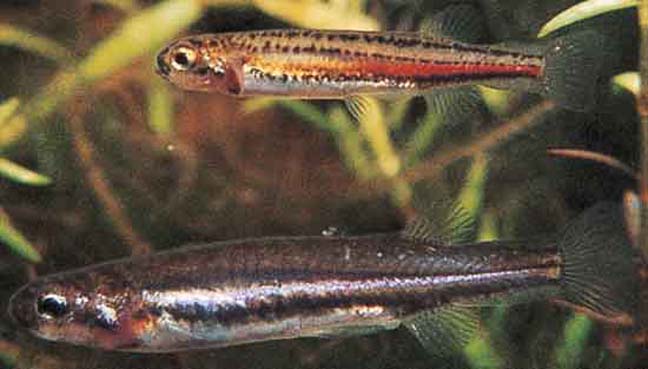Swamp Galaxias, Galaxias parvus Frankenberg 1968

Swamp Galaxias Galaxias parvus. Source: Michael Hammer. License: all rights reserved
A pale grey to yellowish-brown galaxias with some small spots and flecks speckled on the back and sides, and a white underside.
Swamp Galaxias, Galaxias parvus Frankenberg 1968
More Info
|
Distribution |
Known only from Lake Pedder and the headwaters of the Gordon and Huon Rivers, Tasmania. Inhabits swamps, backwaters and pools of streams draining into the lake. Individuals shelter among rocks and vegetation. |
|
Features |
Dorsal fin 10-14; Anal fin 11-15; Pectoral fin 11-14; Pelvic fin 5-6; Gill rakers on first arch 9-13; Vertebrae 44-49 Body slender, tubular, elongate tapering to a long caudal peduncle; body depth 11.6-15.4% SL; head blunt, rounded; mouth small, reaching to front of eyes; jaws equal, lacking lateral canines; anterior nostrils elongate and tubular, reaching forwards over upper lip; 3 preopercular pores; caudal peduncle depth 48.3-63.4% caudal peduncle length; no pyloric caeca. Scales absent Fins small, fleshy-based; caudal fin rounded; dorsal fin rounded, originating above vent, forward of the anal but distinctly behind the pelvic fins; anal fin rounded, origin a little further back than dorsal; pectoral fins small and fan-shaped. |
|
Size |
To 10 cm SL. |
|
Colour |
Pale grey to yellowish-brown overall, some speckling of small spots and blotches on back and sides; white ventrally. |
|
Feeding |
Feeds on small invertebrates including aquatic insects and their larvae. |
|
Biology |
The entire lifecycle is completed in freshwater. Spawning is thought to occur in late winter or spring following rains, with the eggs taking 26-30 days to hatch. Larvae are around 7 mm at hatching, and metamorphose after 30-45 days old at about 20 mm in length. Males may mature at around one year old, whilst females most likely mature at about 2 years of age and 55 mm in length. |
|
Conservation |
Although initially abundant after the flooding of Lake Pedder in the early 1970's, Swamp Galaxias no longer occur in the lake. The species is thought to have declined due to habitat loss and competition and predation from brown trout (Salmo trutta) and climbing galaxias (Galaxias brevipinnis. |
|
Similar Species |
Unique amongst Galaxias in having 3 preopercular pores instead of 4. |
|
Species Citation |
Galaxias parvus Frankenberg 1968, Aust. Zool. 14(3): 270, pl. 15. Type locality: Pond on the east bank of Lake Pedder, about 400 yards south of the stream entering Lake Pedder from Lake Maria, southern Tasmania. The type locality was flooded following the impoundment of Lake Pedder. |
|
Author |
Gomon, M.F. & Bray, D.J. 2016 |
|
Resources |
Swamp Galaxias, Galaxias parvus Frankenberg 1968
References
Allen, G.R. 1989. Freshwater Fishes of Australia. Neptune, New Jersey : T.F.H. Publications 240 pp., 63 pls.
Allen, G.R., Midgley, S.H. & Allen, M. 2002. Field Guide to the Freshwater Fishes of Australia. Perth : Western Australian Museum 394 pp.
Andrews, A.P. 1976. A revision of the family Galaxiidae (Pisces) in Tasmania. Australian Journal of Marine and Freshwater Research 27: 297-349.
Frankenberg, R.S. 1968. Two new species of galaxiid fishes from the Lake Pedder region of southern Tasmania. The Australian Zoologist 14(3): 268-274 pls 14-15
Last, P.R., Scott, E.O.G. & Talbot, F.H. 1983. Fishes of Tasmania. Hobart : Tasmanian Fisheries Development Authority 563 pp. figs.
McDowall, R.M. 2006. Crying wolf, crying foul, or crying shame: alien salmonids and a biodiversity crisis in the southern cool-temperate galaxioid fishes? Reviews in Fish Biology and Fisheries 16: 233-422.
McDowall, R.M. & Frankenberg, R.S. 1981. The galaxiid fishes of Australia. Records of the Australian Museum 33(10): 443-605 figs 1-47
McDowall, R.M. & Fulton, W. 1996. Chapter 10. Family Galaxiidae — galaxiids. pp. 52-77 in McDowall, R.M. (ed.) Freshwater Fishes of South-eastern Australia. Sydney : Reed Books 247 pp.
Merrick, J.R. & Schmida, G.E. 1984. Australian Freshwater Fishes Biology and Management. Sydney : J.R. Merrick 409 pp. figs 280 col. figs.
Raadik, T.A. 2011. Systematic revision of the Mountain Galaxias, Galaxias olidus Günther, 1866 species complex (Teleostei: Galaxiidae) in eastern Australia. Ph.D thesis, University of Canberra. pp. i-xxiii, 1-493
Raadik, T.A. 2014. Fifteen from one: a revision of the Galaxias olidus Günther, 1866 complex (Teleostei, Galaxiidae) in south-eastern Australia recognises three previously described taxa and describes 12 new species. Zootaxa 3898(1): 1-198.
Unmack, P.J. 2001. Biogeography of Australian freshwater fishes. Journal of Biogeography 28: 1053-1089.
Wager, R. 1996. Galaxias parvus. The IUCN Red List of Threatened Species 1996: e.T8807A12933497. http://dx.doi.org/10.2305/IUCN.UK.1996.RLTS.T8807A12933497.en. Downloaded on 03 January 2017.


